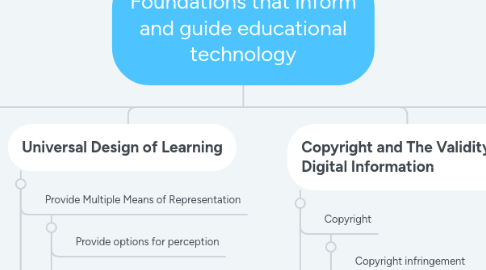
1. Digital Citizenship and Online safety
1.1. What is digital citizenship
1.1.1. Digital Access
1.1.2. Digital Commerce
1.1.3. Digital Communication and Collaboration
1.1.4. Digital Literacy
1.1.5. Digital Fluency
1.1.6. Digital Health and Welfare
1.1.7. Digital Law
1.1.8. Digital Rights and Responsibility
1.1.9. Digital security and Privacy
1.2. Protect yourself Online
1.2.1. Use 2 factor authentication
1.2.2. Don't use the same password everywhere
1.2.3. Update the software on your computer
1.2.4. Be careful with how much info you post online
1.2.5. Be careful when sharing personal info.
2. Universal Design of Learning
2.1. Provide Multiple Means of Representation
2.1.1. Provide options for perception
2.1.2. Provide options for comprehension
2.2. Provide options for language, mathematical, and symbols
2.3. Provide Multiple means of Action and Expression
2.3.1. Provide options for executive functions
2.3.2. Provide options for expression and communication
2.3.3. Provide options for physical action
2.4. Provide Multiple Means of Engagement
2.4.1. Provide options for recruiting interest
2.4.2. Provide options for sustaining effort and persistence
2.4.3. Provide options for self-regulation
3. Copyright and The Validity of Digital Information
3.1. Copyright
3.1.1. Copyright infringement
3.1.2. Plagiarism
3.2. Evaluating Online Information
3.2.1. Who, Why, Where
3.2.2. Check if the item is peer reviewed.
3.2.3. Does the item include a reference
3.2.4. How current is the information
4. Theoretical foundations of learning
4.1. Case based learning
4.2. Project based Learning
4.3. Three main perspectives
4.3.1. Behaviorism
4.3.2. Cognitive-perspective
4.3.3. Constructivism

